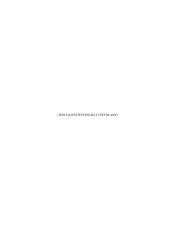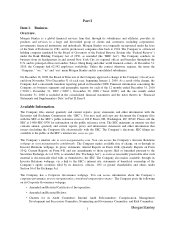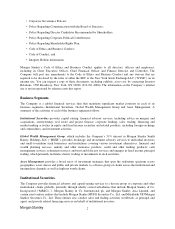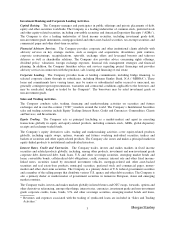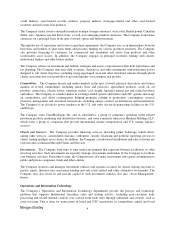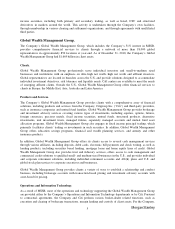Morgan Stanley 2010 Annual Report Download - page 16
Download and view the complete annual report
Please find page 16 of the 2010 Morgan Stanley annual report below. You can navigate through the pages in the report by either clicking on the pages listed below, or by using the keyword search tool below to find specific information within the annual report.
Under current regulations implemented by the Federal Reserve, if any depository institution controlled by a
financial holding company no longer meets certain capital or management standards, the Federal Reserve may
impose corrective capital and/or managerial requirements on the parent financial holding company and place
limitations on its ability to make acquisitions or otherwise conduct the broader financial activities permissible for
financial holding companies. In addition, as a last resort if the deficiencies persist, the Federal Reserve may order
a financial holding company to cease the conduct of or to divest those businesses engaged in activities other than
those permissible for bank holding companies that are not financial holding companies. Under the Dodd-Frank
Act, beginning in July 2011, the financial holding company status will also depend on remaining well capitalized
and well managed at the holding company level. See also “—Capital Standards” below.
Current regulations also provide that if any depository institution controlled by a financial holding company fails
to maintain a satisfactory rating under the Community Reinvestment Act of 1977, the Federal Reserve must
prohibit the financial holding company and its subsidiaries from engaging in any additional activities other than
those permissible for bank holding companies that are not financial holding companies.
Activities Restrictions under the Volcker Rule. A provision of the Dodd-Frank Act (the “Volcker Rule”) will,
over time, prohibit the Company and its subsidiaries from engaging in “proprietary trading,” as defined by the
regulators. The Volcker Rule will also require banking entities to either restructure or unwind certain
relationships with “hedge funds” and “private equity funds,” as such terms are defined in the Volcker Rule and
by the regulators. Regulators are required to issue regulations implementing the substantive Volcker Rule
provisions during the course of 2011. The Volcker Rule is expected to become effective in July 2012, and
banking entities will then have a two-year transition period to come into compliance with the Volcker Rule,
subject to certain available extensions.
While full compliance with the Volcker Rule will likely only be required by July 2014, subject to extensions, the
Company’s business and operations are expected to be impacted earlier, as operating models, investments and
legal structures must be reviewed and gradually adjusted to the new legal environment. The Company has begun
a review of its private equity fund, hedge fund and proprietary trading operations; however, it is too early to
predict how the Volcker Rule may impact the Company’s businesses.
Systemic Risk Regime. The Dodd-Frank Act establishes a new regulatory framework applicable to financial
institutions deemed to pose systemic risks. Bank holding companies with $50 billion or more in consolidated
assets, such as the Company, became automatically subject to the systemic risk regime in July 2010.
Under the systemic risk regime, the Federal Reserve must establish enhanced risk-based capital, leverage capital
and liquidity requirements. These requirements have to be more stringent than standards for institutions that do
not pose systemic risks. Those more broadly applicable U.S. capital and leverage standards will become
significantly more onerous, and will be supplemented by liquidity requirements, such as those promulgated by
the Basel Committee. The enhanced capital, leverage and liquidity standards under the systemic risk regime are
expected to place additional demands, beyond those under Basel III, on systemically important financial
institutions including the Company. The exact form, scale and timing of introduction of any such enhanced
requirements are unclear and will have to be established by rulemaking. The Financial Stability Board has also
announced that it will, together with national authorities, determine in 2011 which financial institutions are
“clearly systemic to the global financial system” (“G-SIFIs”), and recommend an additional degree of loss
absorbency for these institutions. A peer review council will be established with the aim of ensuring consistent
application of measures across G-SIFIs in light of the risks they pose.
The systemic risk regime calls for the establishment of extensive, rapid and orderly resolution plans (“resolution
plans”). The establishment and maintenance of resolution plans requires systemically important financial
institutions, including the Company, to analyze and provide substantial amounts of information regarding their
legal entity structure, assets, liabilities, security arrangements and major counterparties and could entail
significant restructuring of operations. The Federal Reserve and the Federal Deposit Insurance Corporation (the
“FDIC”) will review resolution plans for adequacy and, if they are found to be inadequate, can require changes in
10


